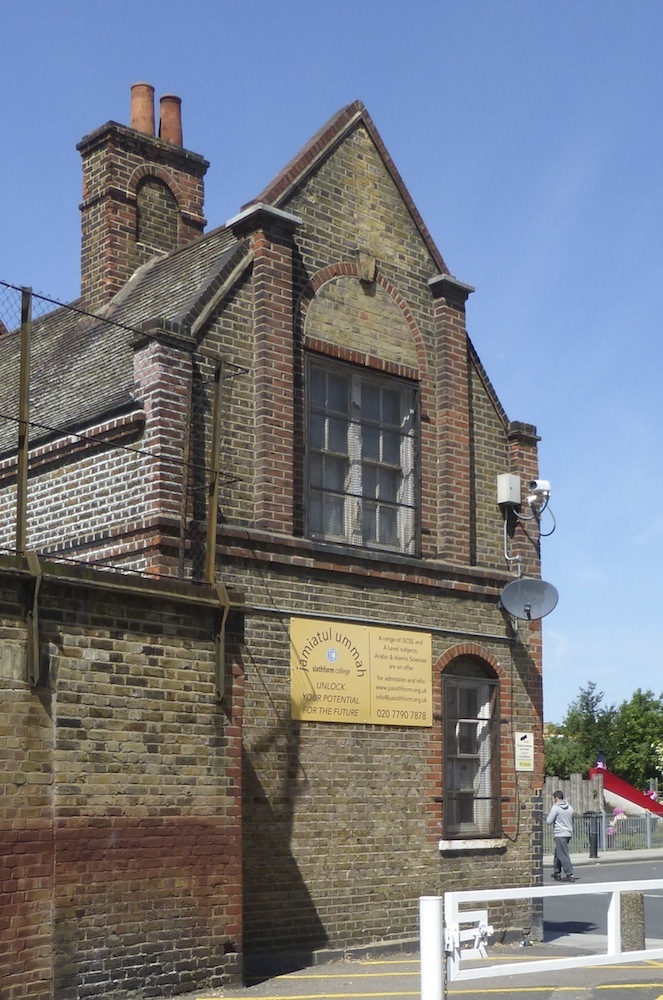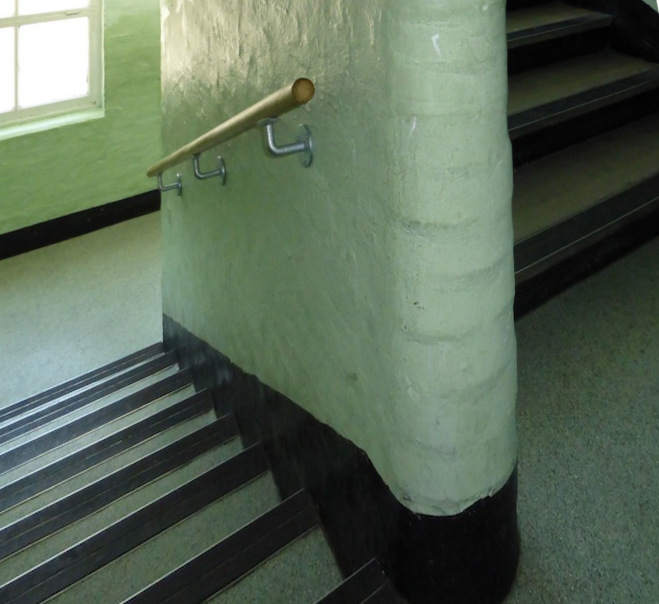Many thanks to Ehsan Hannan, Interim Principal of JU School for Boys (Jamiatul Ummah School) for welcoming me to the school and showing me round. Photographs by the present author. You may use the images without prior permission for any scholarly or educational purpose as long as you (1) credit the photographer and (2) link your document to this URL in a web document or cite the Victorian Web in a print one. Click on the images to enlarge them.
Exterior

The upper storeys of the eastern side of the school, seen over a parking lot, with a 22-storey tower block in the background.
Former Chapman Street School, now Jamiatul Ummah School, designed by Edward Robert Robson (1836-1917) in the first half of 1873, and built 1874-75, with a major extension in 1885-86 by T. J.Bailey (1843-1910) and later additions. The school is in Shadwell, Tower Hamlets, London E1. In fact, the eastern side shown above is mainly Bailey's extension, built against the rear of Robson's original block, and only includes a section of Robson's building to the north. Note the rooftop railings which fence in the playground at the top, and the London School Board's proud, distinctive plaque, its decorative surround reaching into the south-eastern gable. According to the recommendation for listing by Historic England, this was one of the first schools designed by Robson for the London School Board. It was given its Grade II listing only in 2010, in a bid to preserve it from demolition, in an area where much else has changed (see reports from that time, such as "Mosque Plans" and "Early London Board School").



Left to right: (a) Close-up of the London School Board plaque on the eastern elevation: "S. B. L. Lower Chapman Street School." (b) Part of Robson's western elevation, the three-storey frontage on Tillman Street, with plaques either side of the central motif reading, "School Board for London" and "Ann Street School Tower Hamlets." (c) Close-up of the central plaque here, depicting "Knowledge Strangling Ignorance," by Spencer Stanhope.
Bailey, who had probably first met Robson through their links with Ewan Christian, became his assistant in 1778, and succeeded him as Architect to the London School Board at the beginning of 1885 (see Walder). His additions were evidently intended to blend in with Robson's original range, and so are of the same materials and in a matching style. The materials used for both were typical London stock brick, which Robson himself advocated, but, as he specified in his book, School Architecture, "relieved by some intermixture of red" (296). There are also some stone dressings (the keystones, and scrolling around the south-east gable), and plenty of sash windows of varying heights and design, their timber frames painted a contrasting white. As the listing text says, the building "displays the hallmarks of Robson's developing Queen Anne house style": Robson felt that this style would help the buildings to "approach more nearly the spirit of our own time," though he wanted to avoid any "servile copyism" and hoped instead to capture the spirit of the style, in this way clothing the School Board's rendering of it "with new form and a higher sense of architectural being" (323).
Despite its graceful Pre-Raphaelite manner, the sculpted relief of Ignorance being attacked by Knowledge seems rather violent for a school wall, but it was approved by Robson and is found on other early Board Schools too (see Robson 314; Cherry et al., 494). The plaque to its right uses the old name of Tillman Street — Ann Street. But the school got its "Lower Chapman Street" name from the street on the eastern side (confusingly, this is now called Bigland Street). The survival of so many original features like this, from the plaques themselves to the outbuildings, is, of course, of great historic interest, even if some no longer serve their intended purpose.




Left to right: (a) Infants School entrance (converted to a window, perhaps in 1885-86, when Bailey's additions were built). (b) Girls School entrance, with the original wooden door. (c) Cookery classes were held in the single storey building to the left, with the big chimney serving the cooking range. (d) The former school-keeper's house.
Even in these restricted East End sites, Board Schools provided girls and boys with separate entrances, where possible on different streets. This was the convention then (for example, see Robson 302). However, the girls' and infants' entrances were side by side, because girls were expected to bring their younger siblings to school (see Jones 19). These younger children went straight from their door to their own classrooms on the ground floor, while the girls had to climb several flights of steep stairs to their own top floor classrooms. The listing text tells us that boys were taught in between, on the middle floor. According to Robson, this allowed "greater space [to] be obtained in the mezzanine floors for the greater quantity of feminine clothing in cloaks and shawls as compared with that of boys." Giving another passing insight into the conditions of the time, he adds, "Few of the latter, attending Elementary schools belonging to the Board, are found to possess an overcoat" (304). Gender assumptions and divisions are more blatantly seen in the provision of a dedicated building for cookery and housekeeping classes, added in 1882. The listing text dates the school-keeper's house, another accretion, to 1885-86.
Interior



Left to right: (a) An old narrow box stair. (b) On another stairwell, stairs continue upwards round a sharp corner, with no landing for children to intermingle. (c) Older timber stairs turn another sharp corner.
Inside the school, one of the most important strategies for keeping the sexes separate from each other, as far as possible even out of sight of each other, was the construction of cleverly-planned stairways. When the question of listing the building arose in recent years, one of the features particularly noted was the double stairway which belongs to the 1874-5 section, and has survived with its original metal balustrade and handrail intact. The metal changes to timber as it climbs further up.

A light and airy classroom in the projecting bay, in use today. The school, supported by local parents, currently accommodates about 160 fee-paying boys aged from 11-16, and gets excellent results.
"The windows will be ample, and so disposed as to throw the light in the right places, as well as to be useful for summer or occasional ventilation," wrote Robson (6). Much thought was also given to the arrangement of classrooms and desks, "from a desire to isolate each scholar so far as compatible with a convenient form of class. Both have for their object the increased concentration of the child on his lesson, without unnecessary sources of distraction" (Robson 170). Comfort, and the teacher's angle of vision, were both considered as well, and, with these in view, Robson favoured double desks rather than desks in rows, a feature that he had noted in Dutch schools (170). Rooms could be made adaptable by the use of sliding or curtained partitions: Robson shows plans for a single classroom of 40, and a double one of 80. After all, the number of pupils to be catered for was large, and rapidly expanding. The listing text explains that originally the Lower Chapman Street School "was built to accommodate 199 boys, 203 girls and 222 infants, with places for a further 140 boys, 141 girls and 155 infants when the design was completed in 1875," and that when it was extended in 1885-86, a "further 120 boys, 120 girls and 170 infants could ... be taken at the school, bringing its total capacity to 1,470 children in 1886."


Left: Art classes were held in a rooftop building, with good natural lighting, behind the gable at the south-east where the Lower Chapman Street School plaque is displayed. Right: The rooftop playground, which still has its has original shelter for inclement weather.
The concern for fresh air, as well as a recognition of the need for outdoor play, and the necessity of using every available space to the maximum, are all reflected in the provision of a rooftop playground. According to the listing text, the shelter here dates from 1879. Another sign of the ingenious use of space is the very narrow gap visible when looking down from the roof, marking the point at which Bailey's range meets Robson's. Bailey introduced connecting doors between the two on the floors below.
The listing text contextualises the whole vast project of building such schools, by reminding us of how controversial and ground-breaking it was at the time:
The Board did not escape criticism ... both on the grounds of expense to ratepayers and for potentially radicalising the urban poor through secular education. Yet its supporters were unapologetic, as the words of Charles Booth, justifying the expense of more elaborate schools in the East End, indicate: "It was necessary to strike the eye and hold the imagination. It was worth much to carry high the flag of education, and this is what has been done. Each school stands up from its playground like a church in God's acre, ringing its bell." Sherlock Holmes in Sir Arthur Conan Doyle's "The Naval Treaty" (1894) also lauded the new metropolitan landmarks as "Beacons of the future! Capsules with hundreds of bright little seeds in each, out of which will spring the wiser, better England of the future," thus epitomising the reformers' confidence in the power of universal education to transform society. The striking design of many Board and LCC schools is thus illustrative of this special history.
Robson himself had no doubt about his architectural mission: "The importance of education is only beginning to be understood by the average Englishman: that of judicious arrangement of school-buildings lies some distance in the wake," he says at the beginning of School Architecture (3). He set out to remedy this, and his ideas took root. For example, the triple-decker system of infants, boys and girls on ascending levels became the norm in the later 1880s (see Cherry et al. 74). The problem now, as with so much of the Victorian built heritage, is how to help today's local communities preserve these once pioneering buildings and adapt them to their own requirements, within the restrictions imposed on them by statutory listing. It is a daunting and enormously costly task, but there are already some inspiring examples of how it can be achieved, with appropriate support and imaginative planning (see Dungavell).

Sherlock Holmes admires the Board Schools from the train, on the way from Clapham Junction to central London (Sidney Paget's illustration for "The Naval Treaty").
Related Material
- William Edward Forster and Universal Elementary Education
- The First London School Board (painting with commentary)
- Holmes's praise of Board Schools
References
Cherry, Bridget, Charles O'Brien and Nikolaus Pevsner. London: East. New Haven and London: Yale University Press, 2005.
Dungavell, Ian. Saving Our Historic Primary Schools." Cathedral Communications. Web. 6 June 2015.
"Early London Board School Listed at Grade II." The Victorian Society. Web. 6 June 2015.
Jones, Peter Blundell. "The Development of School Building and the Articulation of Territory." In School Design Together. Ed. Pamela Woolner. London: Routledge, 2015. 11-31.
List Entry. Historic England. Web. 6 June 2015.
"Mosque Plans for London School Hit by Listing." The Docklands & East London Advertiser. Web. 6 June 2015.
Robson, Edward Robert. School Architecture. London: John Murray, 1874. Internet Archive. Contributed by OISE, University of Toronto. Web. 6 June 2015.
Walder, Tim. "Thomas Jerram Bailey." Victorian Schools in London, 1870-1914. Web. 6 June 2015.
Created 6 June 2015